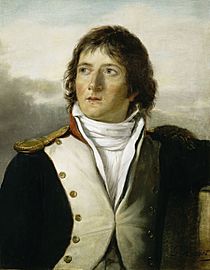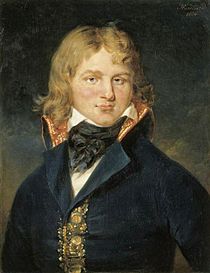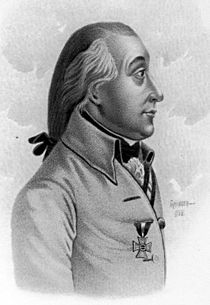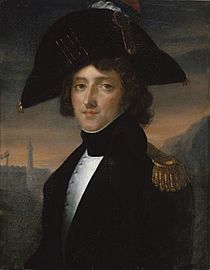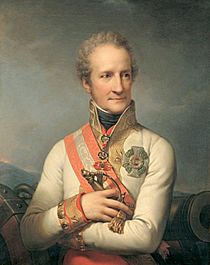Battle of Genola facts for kids
Quick facts for kids Battle of Genola |
|||||||
|---|---|---|---|---|---|---|---|
| Part of War of the Second Coalition | |||||||
|
|||||||
| Belligerents | |||||||
| Commanders and leaders | |||||||
| Units involved | |||||||
| Strength | |||||||
| 29,000–34,000 | 33,498 15,000 participated |
||||||
| Casualties and losses | |||||||
| 2,400 | 7,600, 5 guns | ||||||
The Battle of Genola (also called the Battle of Fossano) happened on November 4, 1799. It was a fight between the Austrian army, led by Michael von Melas, and the French army, led by Jean Étienne Championnet. Melas was a very skilled commander. His army pushed the French back, causing them to lose many soldiers. This battle was the last big effort by the French in Italy during 1799. Genola is a town in northwest Italy, about 27 kilometers (17 miles) north of Cuneo.
Championnet became the French army commander after Barthélemy Catherine Joubert died at the Battle of Novi in August. His main goal was to keep the important fortress of Cuneo under French control. In November, both Championnet and Melas moved their armies forward. They met by chance at Genola. The French army had to retreat into the Alps. This left Cuneo open to attack, and it was captured by the Austrians on December 3, 1799. The French soldiers were poorly fed and clothed. Many got sick with a serious illness during the winter. Championnet himself died from this sickness, along with many others.
Contents
Why the Battle Happened
The French government, called the French Directory, became weaker after their armies lost battles in Italy and Germany in 1799. This led to a change in government on June 18, 1799. France's new leaders sent Barthélémy Catherine Joubert to lead the 40,713-man French Army of Italy. He was ordered to attack.
Joubert was supposed to get help from the Army of the Alps, led by Jean Étienne Championnet. When Joubert arrived, his generals told him to wait for Championnet's troops. But Joubert felt he had to follow his orders and attack right away. At the Battle of Novi on August 15, 1799, the French Army of Italy was defeated. They fought against a larger army of Austrians and Russians, led by Alexander Suvorov. Joubert was killed in this battle.
After their victory, the Austrian and Russian armies did not chase the French. The Austrians were more interested in capturing Italian fortresses. Soon, Suvorov and his Russian soldiers were ordered to march to Switzerland. This left 178,253 Austrian soldiers in Italy. Jean Victor Marie Moreau reorganized the French army until Championnet could arrive to take over.
Meanwhile, Championnet marched from Grenoble around August 8, 1799, with 25,000 soldiers. They split into four groups. The northernmost group crossed a mountain pass to threaten Aosta and Ivrea. The next group crossed another pass to Susa to threaten Turin. Championnet himself went with 8,000–9,000 men. They crossed a pass and moved southeast to Fossano through Pinerolo. The southernmost group marched over a pass towards Cuneo.
On September 16, Paul Grenier with 8,000 French soldiers defeated 5,000 Austrians. This happened near Fossano. The Austrians lost 1,000 men, while the French lost only 200. Two days later, at Savigliano, 20,000 Austrians led by Michael von Melas attacked Grenier's group. They defeated the French, who lost 2,000 men. The Austrians lost only 400. The French lost Fossano and Savigliano and had to retreat. The other French groups also pulled back.
Preparing for Battle
Championnet took command of the Army of Italy from Moreau at Genoa on September 22. The Army of the Alps joined the Army of Italy at this time. Championnet wanted to leave Genoa to make his defense line shorter. But the French government would not let him. The French had about 63,657 soldiers available. If you don't count soldiers in garrisons (fortress guards), there were 53,581.
The French army was divided into wings:
- The right wing, led by Laurent Gouvion Saint-Cyr, had 16,657 soldiers.
- Championnet personally led the center, with 15,215 soldiers near Mondovì.
- Grenier led the left wing, with 19,615 men near Cuneo.
The Austrian forces facing the French were led by Johann von Klenau near Genoa, Paul Kray in the Aosta valley, and Melas, who was threatening Cuneo.
Saint-Cyr's wing successfully fought the Austrians near Genoa. On October 13, François Watrin with 7,000 French troops defeated Klenau with 5,000 Austrians. This happened at Bracco, a village east of Sestri Levante. The French caused 1,200 Austrian casualties, mostly by capturing them. The French lost only 100 men.
On October 24, 1799, Saint-Cyr defeated Andreas Karaczay in the Second Battle of Novi. Karaczay's 5,000 troops lost 300 killed and wounded. The French captured 1,000 men and four cannons. The French lost 400 killed and wounded, and 800 captured. Saint-Cyr then pushed north, so Kray was sent with a strong force to push him back. Saint-Cyr pulled back to the hills behind Novi.
On November 6, in the Third Battle of Novi, Kray attacked the hills. The French troops pretended to retreat, drawing the Austrians after them. Suddenly, Saint-Cyr's hidden cannons fired, and another French division attacked from the side. The French drove the Austrians off the hills. But Saint-Cyr was careful not to chase them into the open plain. The Austrians had better cavalry and cannons there. The French lost 400 men, while the Austrians lost 1,000 men and five cannons.
Further west, there were smaller fights at Saluzzo and Pinerolo. On October 16, 1799, French divisions attacked the Austrians at Beinette. Both sides lost many soldiers. Finally, Melas stopped trying to capture Cuneo and pulled back. On October 31, 1799, Melas with 15,000 soldiers defeated Grenier with 7,000 men at Centallo. The French lost 1,000 soldiers, while the Austrians lost only 200. However, the French slowly moved forward towards Fossano.
The Battle of Genola
On November 3, the French took Saluzzo. Another French group crossed the Stura River to take Murazzo. Championnet decided to launch a big attack the next day.
- The French right wing was to attack the Austrian left side.
- The center was to move against Fossano.
- The left wing was to attack east towards Marene.
- Another French group was to march from Pinerolo to Saluzzo to attack the Austrian right side.
On November 4, the Battle of Genola (or Fossano) began. Championnet thought the Austrians were about to retreat. But Melas had decided to fight and had his army ready.
Both armies started moving early in the day. The first clash happened when Austrian soldiers met Grenier's French division near Marene. The Austrian cavalry joined the fight and pushed the French back a little. But the battle was still undecided. Then, more Austrian troops appeared, which turned the tide. They drove the French from Savigliano.
On the other side, the French attacked Fossano. The Austrians were pushed back three times from Genola. French cavalry, led by Antoine Richepanse, made several successful charges. An Austrian general was killed around this time. More Austrian troops moved to Genola and helped push the French out of the town. The Austrians chased the defeated French division deeper into their lines. Championnet allowed his soldiers to retreat. By the end of the day, the Austrians had pushed the French back significantly.
Meanwhile, another French group arrived late in the afternoon. They were blocked by more Austrian soldiers and had to retreat. Another French group advanced, but Melas ignored them. He focused on defeating the main French forces.
On November 5, the Austrians captured 600 French soldiers. At Murazzo, the Austrians pushed the French rear guard against the Stura River. This forced 1,500 French soldiers to surrender. Others tried to swim the river and drowned. The French abandoned a fort and retreated. The Austrian chase captured another 1,500 French prisoners. Championnet gathered his remaining soldiers, hoping to stop any attempt to capture Cuneo.
Aftermath
The French army lost 3,400 soldiers killed and wounded. They also lost 4,200 men and five cannons captured. The Austrians lost 2,150 killed and wounded, and 250 captured. Melas wanted to capture Cuneo, so he moved against the nearby French forces. On November 10, the Austrians pushed the French back.
On November 13, 1799, 14,000 Austrians attacked Championnet's 9,000 men at Mondovì. Both sides lost about 500 soldiers. Championnet pulled his troops back and set up his headquarters on the coast. On November 15, the Austrians pushed the French completely out of the area.
With the French cleared from Piedmont, Melas ordered his forces to begin attacking Cuneo on November 18. The city was cut off from its water supply on November 21. Trenches for the attack began on the night of November 26. On December 2, the Austrian cannons started firing, breaking through the city's defenses and burning many houses. On December 3, the French commander surrendered. The remaining 3,000 French soldiers, 187 cannons, and a lot of gunpowder were captured.
After the battle, the French Army of Italy was stuck between the mountains and the sea. The area had no supplies left, so food and other things had to be sent from France. But these supply ships were often delayed by bad weather or British warships. On top of this, the soldiers had not been paid in five months. Their clothes and shoes were worn out.
Because of these terrible conditions, many soldiers left the army. Some even rebelled. In one case, Championnet and his chief of staff, Louis Gabriel Suchet, faced 3,000 rebellious soldiers. These soldiers had only received food on six days out of the last thirty. Somehow, the generals convinced them to return to duty. The soldiers in the Genoa garrison also said they were marching back to France. Their general convinced them to stay by explaining they would starve on the long march. Luckily, supply ships reached Genoa just in time.
Championnet was very sad about his soldiers' suffering. On December 31, 1799, Championnet learned that the government accepted his resignation. André Masséna was appointed to lead the Army of Italy. The next day, Championnet became sick. He rapidly got worse and died on January 9, 1800. He was so poor that his staff had to pay for his burial. Championnet died from a serious sickness that had spread through the army and local people.
Images for kids


